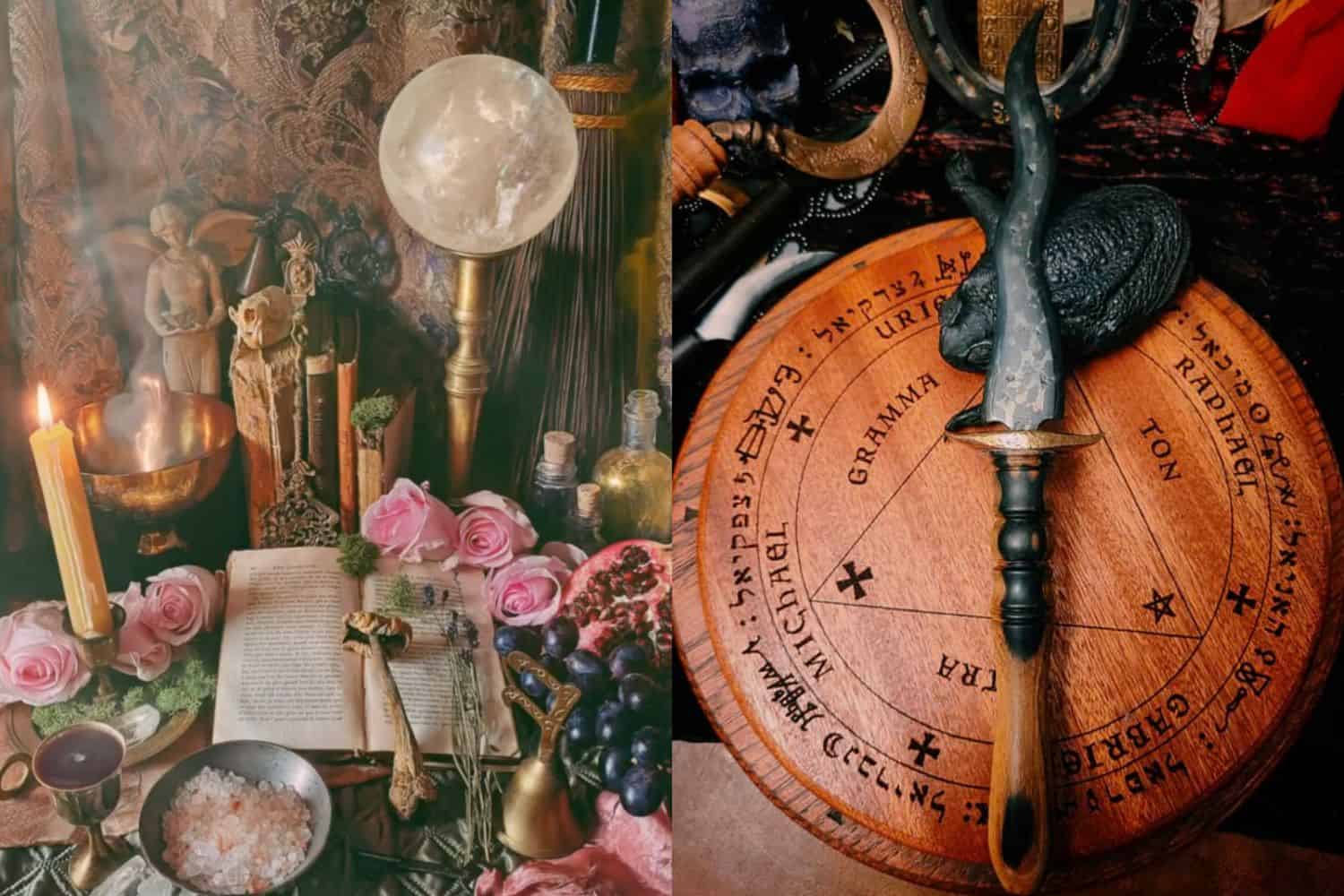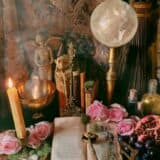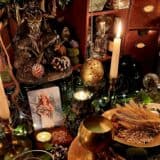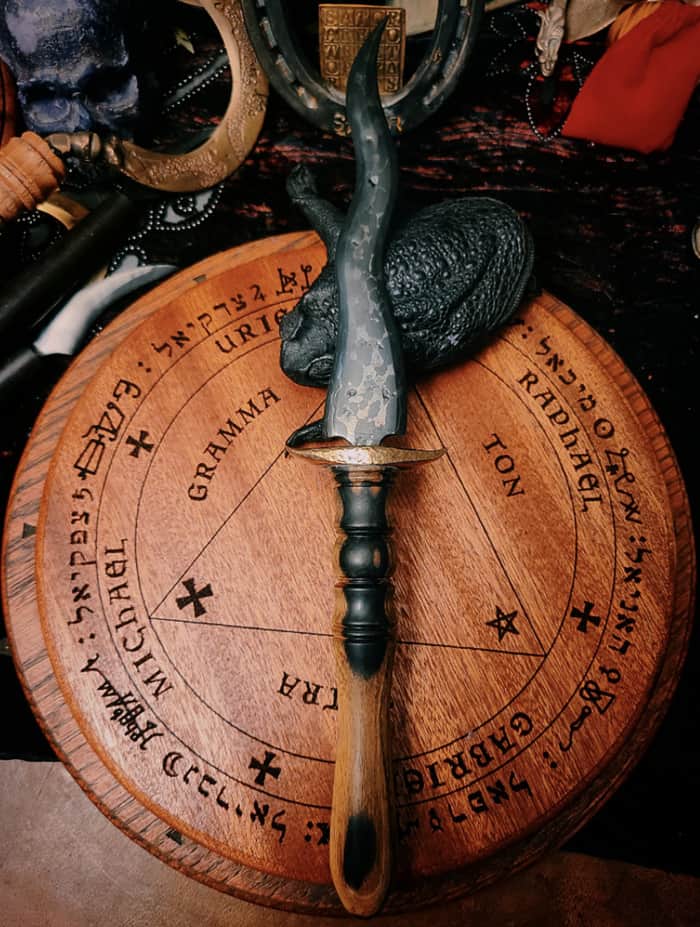How To Build An Altar For Your Spiritual Practice
Everything you need to know to build your sacred working space.

As an Amazon Associate we earn from qualifying purchases. This post may contain affiliate links from Amazon and other sites that we collect a share of sales from. You may learn more here.
In many of our posts about the pagan holidays or witchcraft, we talk about working with your altar. But, if you’ve never built an altar, where do you begin? What tools do you need? How much space does an altar require? Do you need to change it for each season?
These are all good questions. Altars are very personal creations. Some, like mine, are working altars where you practice magic on the space. Others are sacred spaces that remain static but are filled with objects charged with energy for a particular purpose. These may include honoring a god, your ancestors, or to focus energy or set a particular intention.
So, here’s your quick guide on how to make an altar, keeping in mind that there is no wrong way to do it.
Why Make An Altar?
An altar is a place where you can focus your spiritual practice. Whether you’re using it as a place to honor gods or loved ones or you’re using it as a space to do spellwork and manifest your desires, having a dedicated space helps you focus your intentions.
It’s like having a home gym for your spiritual work. You could do your workouts wherever in the house, but you’ll probably be more focused (and successful) if you have a dedicated spot for them. The same is true when it comes to setting intentions.
The Essential Components of Altars Include:
- A sacred space to hold the objects.
- Tools to do the work.
- Objects important to you or to the being you are honoring.
Do You Need to Build an Altar?
To do witchcraft or honor the gods or the seasons, you don’t need a home altar. Plenty of people have been practicing witches and have not had their own altar for many reasons.
Maybe they didn’t have space for one. Maybe their community shunned pagans or witches. Maybe they weren’t out to their loved ones or community about being a witch and had to practice in secret.
If you don’t have an altar, that’s totally ok. If you would like an altar, but need to keep it somewhat secretive (or you need to keep it small because of space concerns), you can make an altar in a jar. Here’s an example of one for Samhain from Wiccan Tips.
Choosing the Best Surface for Your Altar
What you use as your altar depends on how you are going to use it. I have a working altar, so it gets messy. It’s covered in ash and wax and dust. It has burn marks and remnants of paint.
I use the top of my dresser as my altar and even though it does require me to ask friends to not set things on it (as one might do with a normal dresser), it gives me lots of space on which to work when I do practice. And, I don’t worry about it getting ruined.
On the other hand, if you are building an decorative altar where you plan on placing objects of importance to you but don’t need a surface on which to work, a smaller space or even a fancier one may serve well. An altar can take over a dining room table or be in the back of your closet or even in your garden.
What Direction Should Your Altar Face?
It’s generally recommended that altars be on the East wall. This way, when you are standing in front of your altar and ready to work, you are facing East.
Why East? East is the direction that the Sun and the Moon rise from and, if you’re working with nature’s energies, starting your work facing in this direction means that you’re facing what is coming towards you rather than what has been.
Christian churches face East, but this practice dates back far beyond monotheism.
In the Ten Books of Architecture, Roman architect Vitruvius Pollio wrote in the 1st century BC that the temple and statues of the deities should face West, “This will enable those who approach the altar with offerings or sacrifices to face the direction of the sunrise in facing the statue in the temple, and thus those who are undertaking vows look toward the quarter from which the sun comes forth, and likewise the statues themselves appear to be coming forth out of the east to look upon them as they pray and sacrifice.”
He continues, “Altars should face the east, and should always be placed on a lower level than are the statues in the temples, so that those who are praying and sacrificing may look upwards towards the divinity. They are of different heights, being each regulated so as to be appropriate to its own god.
Their heights are to be adjusted thus: for Jupiter and all the celestials, let them be constructed as high as possible; for Vesta and Mother Earth, let them be built low. In accordance with these rules will altars be adjusted when one is preparing his plans. Having described the arrangements of temples in this book, in the following we shall give an exposition of the construction of public buildings.”
What Happens If I Can’t Place My Altar On the Eastern Wall?
If you cannot place your altar on the East wall or in the Eastern corner, don’t worry. Pollio offered other suggestions, some of which may fit your situation. “But if the nature of the site is such as to forbid this, then the principle of determining the quarter should be changed, so that the widest possible view of the city may be had from the sanctuaries of the gods.
Furthermore, temples that are to be built beside rivers, as in Egypt on both sides of the Nile, ought, as it seems, to face the river banks. Similarly, houses of the gods on the sides of public roads should be arranged so that the passers-by can have a view of them and pay their devotions face to face.”
What Goes On an Altar?
It depends. If you practice nature-based magic, you may want to have a tool or object that represents each of the four elements. If you work with deities, you may want to have some candles, incense, or a statue representing them. If you are constructing an altar to honor your ancestors, you may want to include their photographs or items of theirs.
The objects present on an altar may change with the seasons or holidays as well. And, it is absolutely OK to continue to add and remove objects from the altar to keep it fresh and keep the energy moving. Before you add an object to your altar, it’s recommended you consecrate it.
All of that said, if you’re doing witchcraft, there are some common objects you’ll find on an altar.
1. Athame
The athame is a double-edged knife used to draw protective sigils, casting the circle, and doing energetic work, such as invoking the pentagram. It often has a black handle, but does not have it. It represents the element of Air, or sometimes Fire.
It’s recommended to not let anyone else use your athame and you should only use your athame for energetic work, not for carving into candles or other physical workings.
2. Chalice
The chalice is a cup used to purify you and your working area. It represents the element of Water. You can use any cup, but I prefer to have one solely that I use only for ritual and ritual feasts.
3. Wand
The wand is an object used to create the circle of protection, though the athame can be used as well. It represents the element of Fire, or sometimes Air. You can purchase a wand at your local metaphysical or witchcraft shop and there are many beautiful ones on online. Or, find a stick that connects with you the next time you’re in the woods.
4. Pentacle
The pentacle is an object with a magical symbol drawn or carved into it that you place items on to charge and consecrate them. It represents the element of Earth. You may make your own pentacle or purchase one.
5. Cauldron
The cauldron can be used to heat elements used in spells or burn incense. It can also represent the element of Fire. If you want to light things in your cauldron, choose one made from cast iron like this one. Be careful not touch it until it has fully cooled.
6. Incense
Incense can be used to consecrate and protect a space. Some spells call for incense. And, if you’re working with deities, they may prefer certain scents. You can make your own incense, purchase pre-made incense, or work with a witchcraft store that sells herbs to have them create one for you.
When burning incense if you light it using a charcoal disc, be careful not to touch it until it has fully cooled as it can burn as hot as 1500 degrees. Incense is typically burned in a cauldron or censer. Incense represents the element of Air.
7. Candles
Many spells call for candles. What spell you’re doing will inform the candle color you’ll need. You can also leave unlit candles on your altar to represent the colors of certain deities or to represents the four elements. They represent the element of Fire.
8. Water
Some witches choose to have a bowl of water, sometimes Moon water that has been charged under a full Moon, on their altar. It represents the element of Water in a more direct and less symbolic way than the Chalice. A seashell can also represent the element of Water.
9. Boline
A boline is a knife with a curved blade used to carve physical symbols into candles, cut cords, gather herbs, and do any other physical cutting that is required. Where the athame is only used for energetic movements, the boline is meant to be used for physical workings.
10. Deities
This can be a statue or object that represents a particular God or Goddess or a few of them. You could also have objects that represent the divine masculine or divine feminine energies, such as a pine cone and a seashell.
11. Seasonal Offerings
If you choose to honor the seasons or holidays on your altar, each is associated with specific foods, incenses, and colors. Feel free to add these to your standard configuration or swap objects out as you desire. Trust your intuition to see what feels right.
12. Other Tools
Depending on how large your altar is, some other tools you might want to consider keeping on your altar or nearby include a candle snuffer, mortal and pestle, paper to write spells on, crystals, a scrying ball, cords, bells, a lighter, salt, and a ritual plate for food offerings.
At the end of the day, your altar should feel personal and you should feel connected to it, so continue to add and remove objects and tools until you have a sacred space that feels in alignment with your desires. If you need some inspiration, check out these altars.



